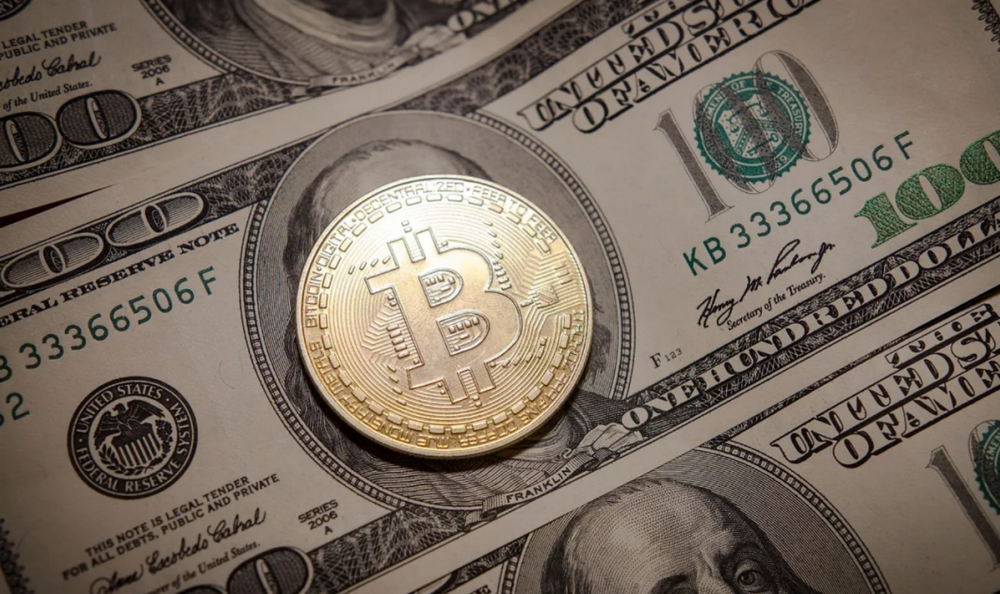Fundamental Labs: 2019/2020, Review and Prospect of Crypto Market Investment
Translator: Howard Yuan
Source: Crypto Valley

It is almost the end of 2019, and it is time to conclude at the end of the year. Looking back at the small trends of investment in the crypto asset market in the past, I have taken a look at some of the seven major market theme hotspots I have observed in order to look to the future. 2020 is another "half year" of BTC. We seem to have been looking forward to this for a long time, but are we all ready?
- Ling Listening to the 2020 New Year's Eve Speech: Finding the "Sense of Blockchain" with 100-Page PPT
- Blockchain Industry Development Trend Report (2019): Systematic Analysis of the Global Blockchain Industry Development Status
- Why does non-homogeneous tokens (NFT) have the opportunity to erupt in the crypto world?


BTC Solo
2019 can be described as a whole roller coaster market, from the darkest moment of the beginning of the year to the violent breakthrough in April, the carnival in June, and then entered a large adjustment for half a year. However, for investors who have experienced the first token financing feast in 2017, the cottage is full of 2019, which is a BTC solo dance market.
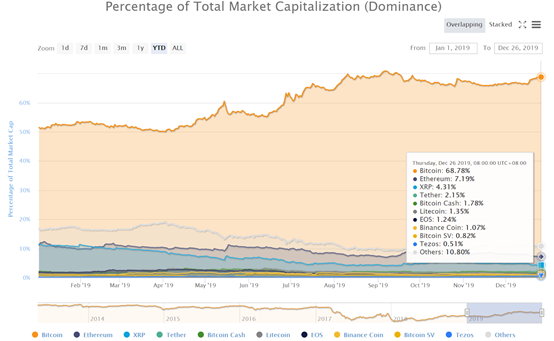
The market value ratio of BTC exceeded 70% at one time. At the beginning of the year, BTC accounted for just over 51%. As of the time of writing, BTC's market value accounted for 68.8%.
In terms of revenue, under the strong squeeze of BTC this year, most cottages underperformed BTC. Among the top ten mainstream currencies, only BNB (23%) and XTZ (39.8%) outperformed BTC, the worst performing XRP, which fell 74% compared to BTC, and the lower-ranked cottages performed worse.

In addition, if liquidity is taken into consideration, we will find that BTC is the only consensus in a bear market. The study of The Block shows that 95% of crypto assets are bleak. At present, BTC's liquidity is 5 times that of ETH, which is other top rankings. 20 times more than crypto assets.

Outlook for 2020:
BTC is the anchor of the entire crypto asset market, with the strongest consensus. Based on the positioning of BTC's "digital gold" and its use as a hedging tool for the world's macro-political and economic risks, BTC is associated with BTC-related infrastructure (custody, derivatives markets, and trusts). Fund), BTC or most traditional institutions are the first choice. We have reason to believe that BTC dominance will continue to be between 60% and 75% for a long time. The Matthew effect of Hengqiang has always been the same in various markets.

DeFi boom
2019 is indeed the first year of DeFi. We are glad to see that the explosion of the DeFi field has brought new topics to the crypto world. Google ’s keyword search has also given a thermal analysis.
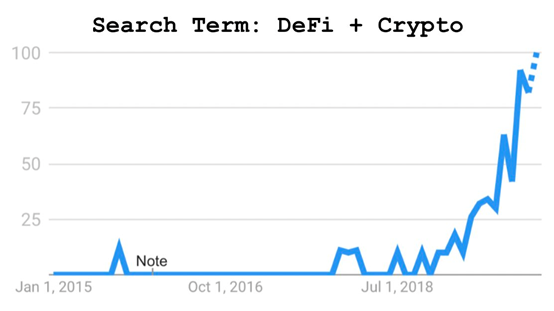
In this year, we saw a 30-fold increase in users, with Compound and Uniswap having the fastest growth.
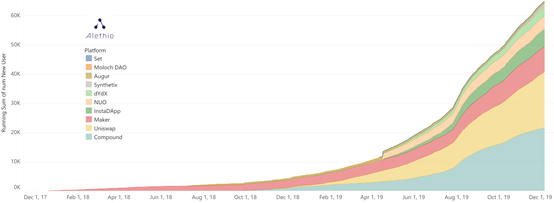
This year, we saw that the total amount of assets locked by DeFi more than doubled to $ 650 million. At the same time, various new products have emerged, such as Uniswap (the size of pledged assets has increased by 52 times) in the decentralized exchange (Dex), InstaDapp (the pledged asset has increased by 267 times) in Lending, Synthetix in derivatives ( From the end of February to December, the size of pledged assets increased by 104 times). Lending's star project Compound has achieved a 6.6-fold increase in pledged assets, while the original borrowing monopoly MakerDAO has achieved a 32% growth despite a decline in market share.
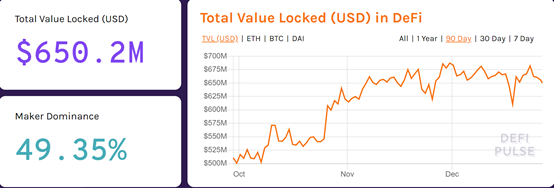
Outlook for 2020:
At present, the only thing that can support ETH's positive fundamentals is the vigorous DeFi ecosystem. We foresee that DeFi will continue to develop in depth. The total size of DeFi is expected to exceed 1 billion U.S. dollars. However, currently, it is subject to Ethereum users, Bottlenecks such as performance and asset size, especially next year's Ethereum PoS upgrade will likely have a greater impact on DeFi. We believe that we should pay more attention to DeFi products on cross-chain protocols such as Polkadot and Cosmos. Through cross-chain technology, we can open up sleeping assets and users on BTC. At the same time, we should pay attention to some high-performance public chains such as Conflux and Algorand in solving DeFi transactions. A useful attempt on performance bottlenecks.

Outbreak of derivatives
In the past year, we have witnessed the explosive growth of many derivative transactions. Some of the original spot-traded exchanges, including Binance, Huobi, and OKEx, have started to provide derivatives products such as futures contracts and options. According to Skew and BitcoinTradeVolume According to .com statistics, the current daily derivative transaction value is nearly US $ 10 billion, which is 7-8 times the spot transaction volume. Even the world's largest spot-based exchange Binance, its 24-hour futures trading volume (US $ 1.134 billion) ) Also far exceeds its 24-hour spot trading volume (US $ 728 million).

In addition to some crypto-native trading derivative exchanges, we see the entry of the regular army, traditional financial institutions such as CME / ICE are also actively entering, and the Chicago Mercantile Exchange CME launched its own BTC futures products in 2017. CME's third quarter report shows that institutional investor customers have strong demand for BTC. CME has nearly 50,000 open contracts daily, an increase of more than 60% over the same period last year.
Bakkt entered the crypto market with the “Halo” of the ICE American Intercontinental Exchange. ICE is the parent company of the New York Stock Exchange. Bakkt was established in 2018. After twists and turns, it finally went online on September 22. It is different from CME's cash delivery. For BTC futures contracts, Bakkt mainly focuses on physical delivery of BTC futures contracts. Although Bakkt's first-day trading volume is only 72 BTC, the data shows that its trading volume is steadily increasing, and its daily trading volume has remained above US $ 10 million in recent days. .
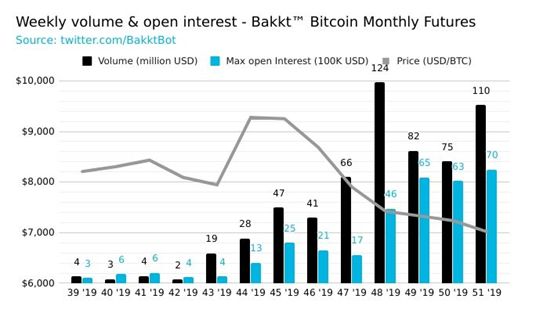
Outlook for 2020:
We expect that the futures-led crypto market will become more and more obvious in the future, and dark horses such as Bybit, FTX and other derivatives exchanges will continue to appear. At the same time, as the exchanges such as OKEx, CME, Bakkt are about to launch options trading, we expect that the derivative trading volume next year will continue to grow, or it may reach 20 times the spot trading volume.

The rise of staking
Staking is a concept that emerged at the beginning of the year. After the major public chains based on PoS, Cosmos, Tezos, and Algorand went online, the Staking economy came into being. As of today, the total market value of the crypto market is US $ 190.3 billion, of which the total market value of staking projects is 10.2 billion, accounting for 5.3%, and the value of these Staking projects is 6.34 billion, and the overall pledge rate is 62.2%.
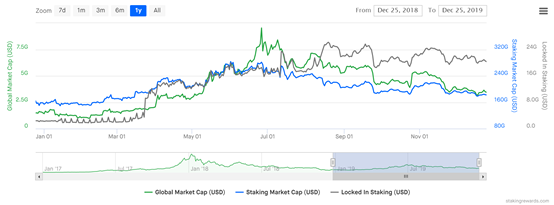
If ranked according to the size of the locked market capitalization, CMC TOP20 projects account for 98% of the Staking sector. Among them, EOS, Tezos, Cosmos, Algorand, Tron, Dash, SNX, etc. are the top ones.
From the perspective of the trend, the value of the tokens locked by Staking has increased from US $ 690 million at the beginning of the year to US $ 6.4 billion at the end of the year, and the total size has increased by 8.3 times.
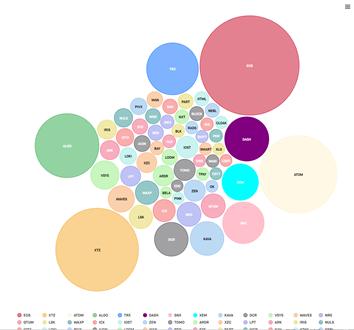
From the perspective of Staking income, the average return of the project reached 12%. Among the top ten Staking assets, DeFi rookie Synthetix has the highest rate of return.
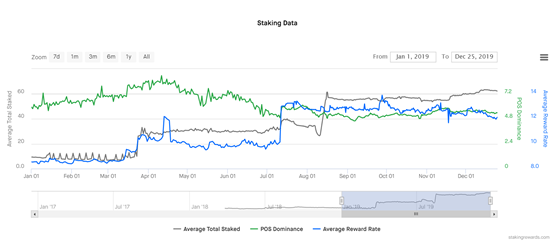
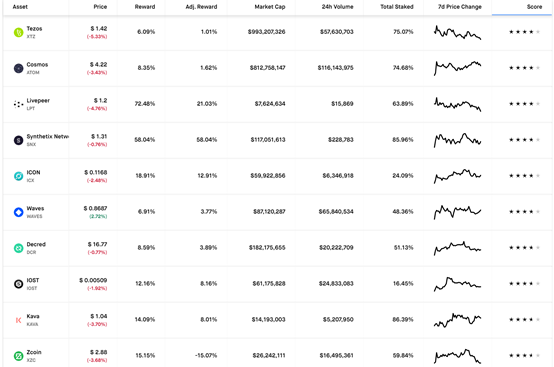
Service providers that provide Staking services have also sprung up, including various wallets, exchange giants and independent third parties. Among them, the strategic entry of Coinbase and Binance has greatly raised the threshold for Staking competition, and wallet service providers mainly include Hashquark, Cobo, Wetez, etc.
Staking is essentially a business of "making money in coins." Staking currency standard rate of return = inflation rate / pledge rate, but if the price is based on the fiat currency, the fluctuation of the currency price itself will greatly affect the yield of the fiat currency of Staking, so choose a suitable investment. Time is more important.
Outlook for 2020:
We understand that Staking itself is the infrastructure of a PoS network. The core lies in maintaining the safe and effective operation of the network. With the upgrade of Polkadot, Dfinity and other mainnets including ETH2.0 next year, we predict that the value of the Staking network will continue to increase.
For quite a long time, PoW and PoS consensus will coexist peacefully, and for investors who choose PoS network construction to participate in the Staking business, it is more important to choose high-quality underlying assets. As for the Staking service providers, compared with the current Staking volume, the participants of this track are too crowded. We predict that there will be a big wave of sand washing in 2020. Only 5-10 service providers with strong financial strength and user traffic advantages can In the end, we expect that Staking will eventually become relatively centralized like PoW mining players.

The melee of stablecoins
2019 is destined to be a chaotic and exciting year for stablecoins, with the exception of USDT, the forerunner of stablecoins, and Libra, to be released by Facebook this year. We have also seen many other stablecoin players running on the field. There are centralized stablecoins issued by traditional financial institutions based on the alliance chain. The representative is JPMcoin issued by JP Morgan Chase. There are many centralized stablecoins issued by exchanges, such as OKK's USDK, Huobi's HUSD, and Binance's BUSDT. In addition, there are many niche DAI-like stablecoins that are collateralizing digital assets are on the way to development.
In the stablecoin market, USDT is almost a monopoly. Even after USDT ’s issuing company Tether experienced allegations of illegal operations in New York State this year, the USDT ’s market performance is still bright. Tether has suddenly become the “cryptocurrency world” The “central bank”, USDT has become the “dollar” of the digital currency world, and is widely used in various trading scenarios. Now, the daily trading volume of USDT has far exceeded that of BTC. The market value of USDT still accounts for more than 80% of the crypto asset trading market. The volume accounts for 95% of all stablecoin trading pairs, and USDT's 24-hour trading volume also steadily surpasses BTC and ranks first in trading pairs.
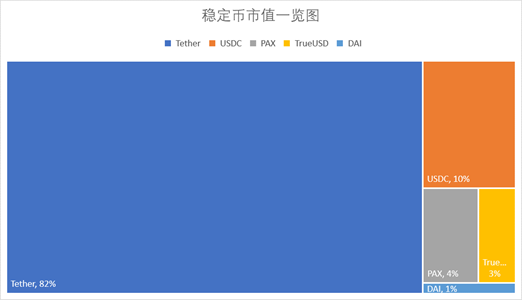
The re-emergence of USDT has contributed to ERC-20. As shown in the chart below, ERC-20 USDT surpassed the OmniUSDT on-chain trading volume in August this year.

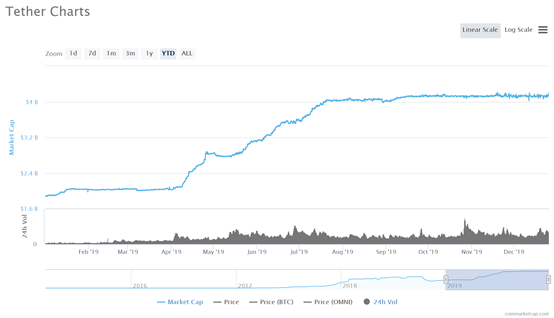

Outlook for 2020:
Who can be the next stablecoin to shake USDT's dominance? Judging from the current development situation of stablecoins, any challenger will not be easy. We predict that USDT is expected to leap into the top three in market value in 2020. In addition to USDT, USDC is also a strong successor. In addition, if we jump out of the current stablecoin landscape, the issue of Libra, issued by Facebook, or the central bank's DCEP, is an unknown variable in the stablecoin market.

The mainstreaming of mining
On November 21, 2019, mining machine manufacturer Jianan Yunzhi successfully listed on the NASDAQ in the United States, becoming the first blockchain concept company listed on the US stock market. The listing of Jianan Yunzhi means that blockchain technology and BTC are increasingly accepted by mainstream financial markets, and the mining industry has entered a new era. In the "Industrial Structure Adjustment Guidance Catalogue (2019 Edition)" announced by the Development and Reform Commission in November, the "virtual currency mining" that was in the phase-out industry in the first draft of comments has been deleted, and BTC mining Go mainstream.
BTC computing power is a stabilizer for the entire crypto asset market. A recent Coinshares report revealed that BTC miners received $ 5.5 billion in block rewards in 2018, of which 5.2 billion were Coinbase rewards and 284 million were from BTC transfer transaction fees. The report predicts that the block rewards in 2019 will reach $ 5.4 billion. The report also shows that 66% of BTC computing power comes from Chinese miners, thanks to the fact that the world's top BTC mining machine manufacturers are all from China.
The growth of computing power seems to be an irreversible trend? If we look at the time, we find that in the past ten years, except for the short period of the fourth quarter of 2018, the computing power has basically been in a state of net growth without fear of adjustments in currency prices.

In May 2020, we are about to usher in the third halving of BTC. In the face of halving revenue, is mining still profitable? In particular, will the BTC price perform in advance?
Let's look at a chart first, a comparison of computing power and price

BTC price has increased by 89% from 3800 $ at the beginning of the year to 7200 $ now
The total computing power of BTC has increased by 151% from 39E at the beginning of the year to 98E at present.
In 2019, the growth of computing power exceeds the increase of BTC price, although in the middle of June to July, the price increase exceeded the increase of computing power, and since the second half of the year, BTC has entered a downward channel, and the computing power is still increasing. Until 10 and the middle of the year, due to the end of the flood season, the growth of computing power gradually slowed down, but it still reached a new high of 111E in December, which also confirmed that the price and computing power are strongly correlated, and the price change must go first As the computing power changes, at a certain point in time, the computing power curve and the BTC price curve will cross and meet again.
Outlook for 2020:
We cannot predict the specific price of BTC after halving next year, but there is no doubt that there is a strong positive correlation between computing power and price, and the computing power curve will continue to grow as we have seen in the figure above. This is also economic and social Like the objective law for forward development, machines with stronger computing power and lower energy consumption will always be produced and attract more mainstream institutions to enter the market, thereby leading the entire industry to continue to move forward. Next year's BTC computing power It is possible to reach around 200E.

The advent of mergers and acquisitions
We made a summary of the public M & A activities that took place in the blockchain market in 2019.It can be seen that there were nearly 30 acquisitions in the entire market in 2019, and a report from Token Data includes unlisted acquisition information. There may be 90-100 cases in the year, and the total amount is expected to be 700 million US dollars.
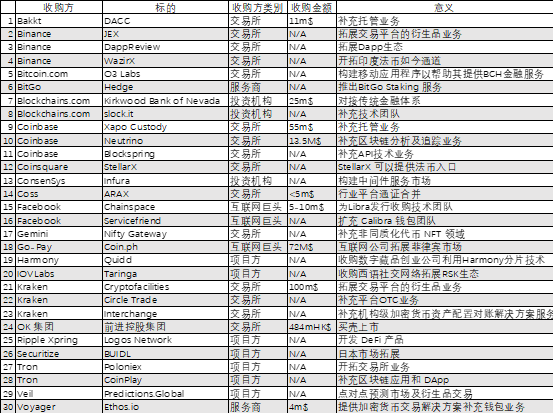
Among them, the exchange is the richest gold owner in the industry, accounting for 50% of the total, and the first of these is the major exchanges Coinbase, Binance, Kraken. In addition, public chain project parties such as RSK are also active acquirers. In addition, Internet companies such as Facebook and Go-Pay have also entered the blockchain market through acquisitions. They are barbarians at the door of the blockchain world.

Outlook for 2020:
The market in 2019 is a trend of rising first and then suppressing. With the entry of Facebook and other Internet giants, we see that the market is gradually entering a stage of resource integration. We predict that more Internet giants will enter this market in 2020. As the largest buyer in the market, the exchange will continue to maintain its market competitiveness through the acquisition of technology, team talents and race tracks. This trend will continue.

2020, our investment strategy
All along, our investment logic is based on a long-term investment and industrial thinking perspective. Specifically, we will adhere to an effective all-weather investment strategy ( β strategy + α strategy + VC / PE ), as follows: As shown.
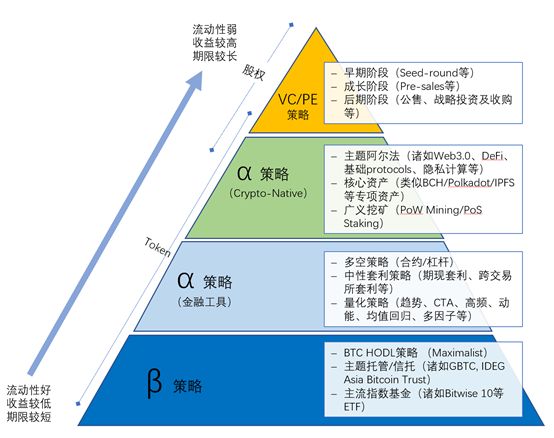
- Beta strategy: We will strive to consolidate the "basic assets" in our portfolio. At this stage, BTC is still the beta of the market, and most traditional institutions will still mainly enter through BTC and mainstream index funds, including custody trust products. This market. The beta strategy means we have higher liquidity.
- Alpha strategy: On the one hand , we use the traditional market financial instruments including futures, contracts or related quantitative strategies to achieve the value of "basic assets"; on the other hand, through some Crypto-Native strategies, including generalized mining, themed alpha, and optimization Core assets and other methods to maximize the value of the investment portfolio.
- VC / PE strategy: This is mainly to maximize investment income through VC investment in the early stage or growth stage. Of course, because we will bear a relatively high degree of risk, we also do not rule out seeking high-quality assets at a suitable time through strategic investment or Mergers and acquisitions to maximize investment returns.
As in the previous article, No.86 | In the second half of blockchain investment, are institutions running and entering? As stated in》, 2020 will be a year when institutional investors need to be fully prepared to enter the world of digital trading assets, and it will also be an opportunity and exciting for the investment institutions we have invested in Year, Ready? Go!

We will continue to update Blocking; if you have any questions or suggestions, please contact us!
Was this article helpful?
93 out of 132 found this helpful
Related articles
- Review 2019 | 100 Blockchain High-Quality Articles (Part 1)
- Twitter Picks | YouTube's "missing" aftermath: netizens don't buy it, V God thinks or has something to do with Google
- Wanfeng Blockchain Xiao Feng: The blockchain is pursuing ecological effects
- Shanghai Stock Exchange initiated the formulation of industry blockchain application technology standards to promote the application of multiple blockchain business scenarios
- Panoramic scan of blockchain in 2019
- Castle Island Ventures Partners' "Eight Prophecies" for 2020
- Year-end Special | Chain Node 2019 Annual Ice Sculpture Awards






